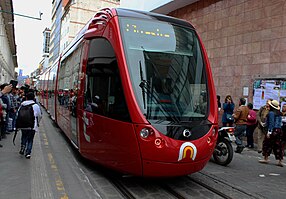Cuenca tram
| Cuenca Tramway (Tranvía de Cuenca) | |
|---|---|
| Tramcars in Cuenca, the center of the track, the APS - busbar | |
| Basic information | |
| Country | Ecuador |
| city | Cuenca |
| opening | February 24, 2019 |
| Infrastructure | |
| Route length | 10.3 km |
| Gauge | 1435 mm ( standard gauge ) |
| Power system | 750 V direct current overhead line and APS power rail |
| Stops | 20th |
| business | |
| Lines | 1 |
| vehicles | Alstom Citadis X05 |
The Cuenca tram , in Spanish Tranvía de Cuenca , is the tram of the 331,000 inhabitant city of Cuenca in Ecuador . The tram service in the South American Andes is the highest in the world.
History and description
The Cuenca tram started operating on a trial basis on February 24, 2019, and regular passenger traffic should begin on April 16, 2019.
Cuenca is the third largest city in Ecuador and is considered the most beautiful city in the country. It is located at an altitude of around 2550 m and an estimated 400,000 people live in its immediate catchment area. Over the centuries it has repeatedly taken in persecuted people from Europe, for example French Jews in the 16th century and German-Jewish refugees at the end of World War II . The French influence cannot be overlooked in the cityscape and is still felt today. The old town is characterized by narrow streets and suffers from the growing traffic.
In 2009 the city administration considered the introduction of a tram for the first time and commissioned a feasibility study in 2010. This resulted in the recommendation for a tram because of the historical buildings without overhead contact lines in the city center. The choice fell on the Alimentation Par Sol (APS) system from the French manufacturer Alstom . The construction of a 10.3 km long route with partial APS operation was agreed with this company. These 14 were articulated cars of the type Citadis X05 ordered, the first of which arrived in Cuenca on July 1, 2015. In October of that year, the first test drives began on sections of the route under contact wire . Since the executing Spanish construction company filed for bankruptcy in autumn 2016 , construction work was suspended until September 2017. The total costs for the project are estimated at almost 300 million US dollars .
A first traffic accident occurred on December 13, 2018, when a car drove into the Avenida de las Américas when turning against the railcar 1001.
On February 24, 2019, the "Marcha en blanco", the endurance test under schedule conditions, went into operation. Eight trains run every five minutes at 50 km / h outside and 20 km / h in the city center. The Tranvía is to replace the bus route 100, which carries 41,000 passengers a day. At the planned five-minute intervals, their maximum daily capacity is 60,000 people.
The fact that no collective bargaining agreement between rail and bus is foreseeable so far could have a disadvantageous effect . In the case of transfer connections, you have to pay individually for each leg.
On May 25, 2020, the tram started passenger traffic. For the time being, it will be offered free of charge daily between 6:00 a.m. and 8:00 p.m., but initially on a trial basis and subject to COVID-19 restrictions.
route
The route connects the populous new development area Control Sur in the southwest of the city with an industrial park with around 12,000 employees. The central bus station and the airport are also served.
Because of the narrow street width, the tracks in the old town were largely laid on two parallel one-way streets running in opposite directions . The APS system was used on this section from Feria Libre station to Terminal Terrestre station. The track in west-east direction runs through the Calle Mariscal Lamar, in the opposite direction the Calle Gran Colombia is crossed.
The depot is located on Avenida Mexico, 500 m from the route. The branch of the operating line there is between the stations Feria Libre and Avenida México.
vehicles
The burgundy painted Citadis X05 seats 207 passengers with 52 seats and 155 standing places. The vehicles built in La Rochelle are 32.6 meters long and 2.4 meters wide. Their front design corresponds to that of the Citadis 302 of the Toulouse tram company . You will look like in the overhead line in the APS - busbar operation with a DC voltage supply of 750 volts.
Web links
Individual evidence
- ↑ a b c d e f The highest! in: Tram Magazin 5/2019, p. 30 ff.
- ↑ Después de cinco años el tranvía da un alivio a Cuenca at eltiempo.com.ec, accessed on April 28, 2019
- ↑ a b Really high: The new Tranvía Cuenca in Ecuador. In: Urban Transport Magazine. June 2, 2020, accessed on June 4, 2020 (German).


